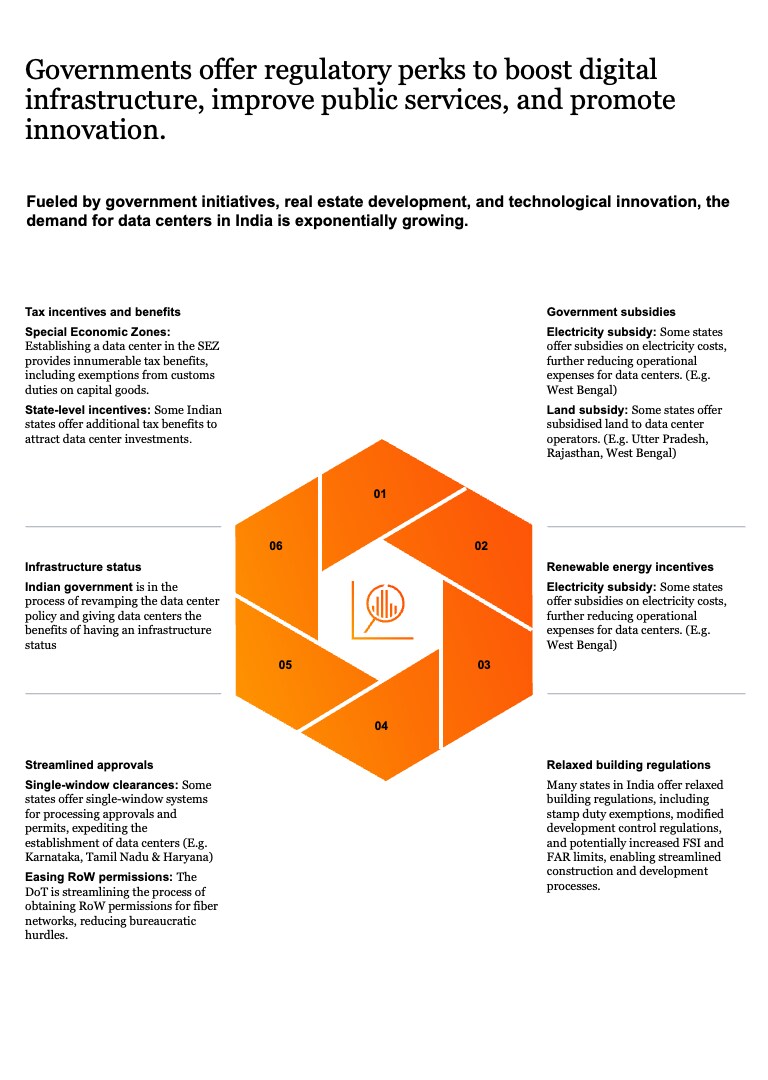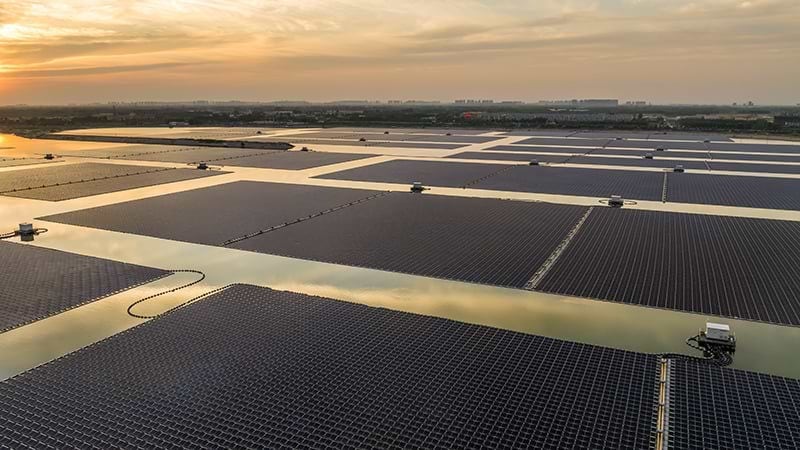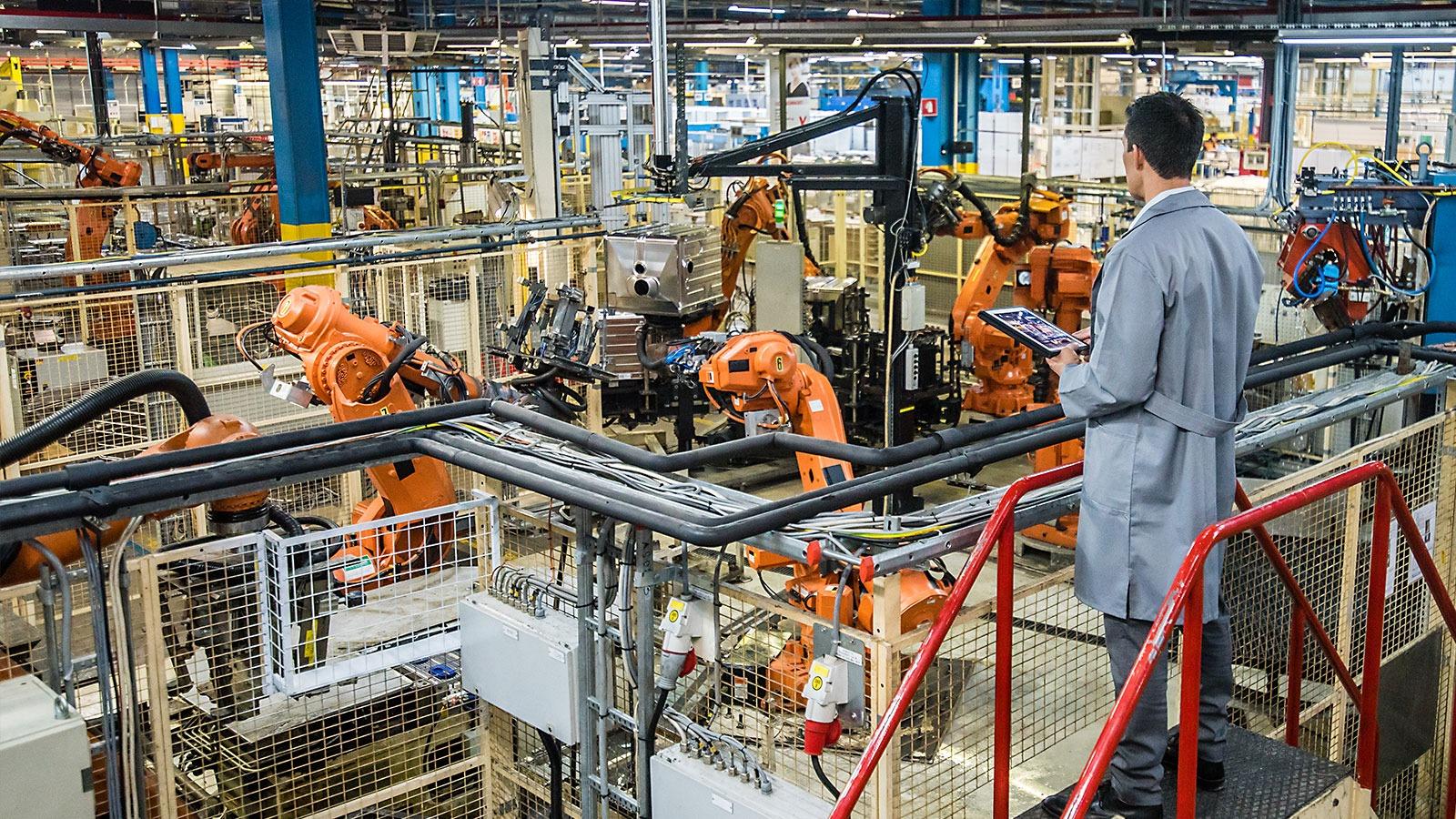We are your end‑to‑end partner for the datacenter lifecycle - from design and finance to build, operate, and decommission.
Data Centers
The Data Center microsite represents our vision for the future of the Data Center advisory market. It brings together the best of PwC’s capabilities from across the globe—spanning strategy, finance, technical, and operational expertise—allowing us to uniquely position our clients to unlock and scale the full value of their Data Center investments. This is home to all your Data Center queries, from proposal starters and project case & citation to CoE collaboration and everything in between.
Data centers sit at the core of the digital economy, enabling connectivity, cloud, and computing at scale. For investors, operators, and enterprises alike, they represent both a critical enabler of transformation and a rapidly evolving asset class. Our team helps clients navigate this complexity by providing end-to-end advisory across the data center investment lifecycle.

The data center ecosystem is diverse—we serve as an orchestrator at the center, supporting data center strategy, finance, build, operations, and exit
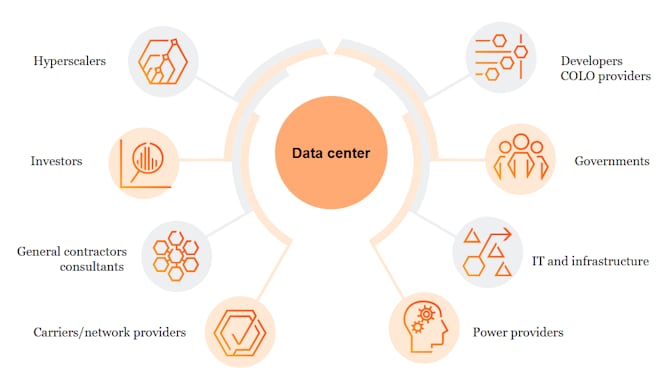
Our strategic support includes:
- Market and investment strategy: Identifying growth opportunities, developing market entry and expansion strategies, and aligning investments to long-term megatrends.
- Design and build advisory: Guiding large-scale data center development, vendor partnerships, and technical design decisions.
- Operational efficiency: Driving performance, resilience, and cost optimisation through benchmarking and process redesign.
- Risk and regulatory management: Ensuring compliance, security, and operational continuity in a volatile environment.
- Tax and structuring: Optimising financial returns through effective structuring, incentives, and cross-border strategies.
- Sustainability and ESG integration: Embedding energy efficiency, renewable adoption, and net-zero alignment into the asset lifecycle.
The data center ecosystem is diverse and globally interconnected. Hyperscalers, colocation providers, investors, governments, and technology players all compete and collaborate within it. We bring global reach and local insight to help clients position themselves at the center of this ecosystem.
Through thought leadership, industry engagement, and client-centric co-creation, we enable organisations to anticipate disruption, capture emerging value pools, and build sustainable competitive advantage in digital infrastructure.
Our datacenter capabilities are designed to help clients not only deliver on today’s priorities but also shape tomorrow’s opportunities—making data centers a true engine of long-term growth.

Rajnil Mallik
With over 25 years' experience in advising C-suite executives at the Global Fortune 1,000 and at large privately-held enterprises in Australia, North America, Asia, Europe, Rajnil has either managed a P&L or launched and expanded new ventures.

Indranil Mitra
Indranil’s role is at the intersection of AI and advanced analytics, where he steers strategic initiatives that reshape industries. With the experience of a senior fellow at the Royal Statistical Society, he has cultivated a deep expertise in data science, evidenced by our team's pioneering research and development.

Ashootosh Chand
Ashootosh’s focus areas are IoT, automation, cloud, platforms, big data and blockchain, AI, and AR. He has launched and managed many multi-million dollar product lines and has grown/nurtured/led high-performing domestic and blended teams.
Meet the team
Key trends
Latest trends in the AI space
Generative AI is now doing far more than chatting with customers. Forward-looking companies are wiring large-language-model “brains” into their core systems so they can instantly summarise long documents, trigger end-to-end workflow actions and mine mountains of unstructured data for hidden insights. The result is faster decisions, lower costs and new sources of value—delivered through responsible, human-led, tech-powered innovation.
There's a growing focus on agentic AI—systems that can autonomously plan, reason, and act to achieve goals. These agents are being used in customer service, software development, and even scientific research.
PwC’s Agent OS is a vendor-agnostic orchestration platform that connects scattered AI efforts into secure, business-ready workflows. Acting like an “AI switchboard,” it lets teams drag-and-drop or code agents, link them into end-to-end processes, and monitor everything from one place. Built on a patent-pending framework that scales agent solutions up to 10× faster while avoiding lock-in.
AI literacy is now a must-have skill. As generative tools embed themselves in everyday workflows, every employee—front-line to C-suite—needs to know how to prompt effectively, interpret and challenge AI outputs, and apply human judgement. Building this capability boosts confidence, safeguards trust and unlocks the full value of intelligent technology across the enterprise.
AI now turns live data into on-the-spot decisions. Logistics networks reroute around traffic in seconds; finance engines flag fraud and price risk before humans can click; customer-service platforms read sentiment and suggest next-best actions. Digital twins add a powerful layer: leaders can run “what-if” simulations—testing supply-chain shocks or pricing moves safely in virtual space—then push winning scenarios straight into production. By blending predictive analytics, dynamic resource allocation and twin-based simulation, firms shift from hindsight reporting to foresight action, gaining speed, savings and resilience while people focus on higher-value judgement.
Multimodal AI is moving centre-stage. New systems can read text, interpret images, listen to audio and watch video in one seamless flow—creating richer, context-aware experiences. Think lesson plans that combine speech and diagrams to personalise learning, clinical tools that match scans to physicians’ notes, and immersive content that adapts to viewers in real time across education, healthcare and entertainment.
With AI permeating every sector, regulators are moving quickly to turn principles into enforceable rules. Organisations are embedding governance frameworks that trace data lineage, audit model bias and demand human oversight for high-impact decisions. Beyond compliance, responsible data sharing, privacy-preserving engineering and sustainability metrics are becoming board-level KPIs.
Sustainable AI is rising to the top of the agenda. Training a single large-language model can emit thousands of tonnes of CO₂, pushing companies to adopt greener practices. Firms are redesigning models to run on slimmer, energy-efficient architectures, pruning parameters, sharing weights and scaling GPUs only when renewable power is plentiful. Carbon-aware schedulers shift heavy workloads to data-centres on the cleanest grids, while liquid cooling trims electricity loss. PwC’s global net-zero-by-2030 pledge keeps sustainability front-and-centre, guiding clients to measure, report and shrink the carbon footprint of every intelligent system
Capabilities
Generative AI is revolutionising various sectors by offering innovative solutions and enhancing productivity. Here are some sector-specific use cases:
Generative AI is not only enhancing operational efficiency across these sectors but also driving innovation by opening up new possibilities and business models.
Our strategic support across the datacenters lifecycle
| Traditional Data Centers | Edge Data Centers | AI Data Centers | |
|---|---|---|---|
| Overview | General-purpose facilities supporting diverse computing tasks | Small, decentralized and positioned closer to users for low-latency use cases | Purpose-built for high-performance computing, particularly AI and machine learning workloads |
| Customers | Hyperscalers | Enterprises | Govt. | ISPs | Telcos | OTTs | Gaming | ISPs | IT Solutions | AI Startups | Hyperscalers | Large Enterprises |
| Services Offered | Co-location | Hosting | Disaster Recovery | Data Storage | Co-location | Edge Computing | High Performance Computing | High Performance Storage |
| Size (MW) Single Site | 3 MW - 35 MW | 250 KW – 2 MW | 75 MW – 300 MW Due to high-performance Servers |
| Tier Certification | Tier 3 & 4 | Tier 2 & 3 As they're only used for localized processing |
Tier 3 & 4 |
| Capital Investment | Medium | Low | High |
With AI, cloud, and high-performance computing driving the demand, data centers must evolve faster, smarter, and more sustainably
Value in motion
Value today is no longer fixed within industries—it is in motion, shifting across markets, ecosystems, and human needs. Megatrends like technology, climate change, demographics, and geopolitics are reconfiguring the economy and creating new value pools beyond traditional sector lines.
India—young, dynamic, and the world’s fastest-growing economy—is uniquely positioned to ride this shift. Indian businesses are transcending industrial silos, building alliances, and unlocking new domains of growth. Our domain-based framework organises these opportunities around human-centric needs such as care, construction, manufacturing, mobility—and critically, how we connect and compute.
How we connect and compute is the backbone of this transformation. As data, networks, and intelligence converge through 5G, cloud, edge, and AI, they power entirely new value chains—reshaping healthcare, enabling smart factories, and driving digital commerce. In many ways, connectivity and compute are the force multipliers of all other domains, turning potential into scalable, real-world value.
Capturing these opportunities demands bold reinvention. Companies must systematically identify the right domains, diversify with discipline, and execute with resilience—because in a world where value is constantly in motion, speed and foresight decide who leads.
India data center market insights
Data center capacity in India has grown exponentially—and we help you capture the momentum
The data center industry faced an inflection point with cloud computing, and today AI is driving exponential future growth
From Tier-1 to Tier-2, the pipeline is deepening—more sites, lower latency, better economics
Key data center capacity distribution

Multiple factors driving growth for Indian data centers
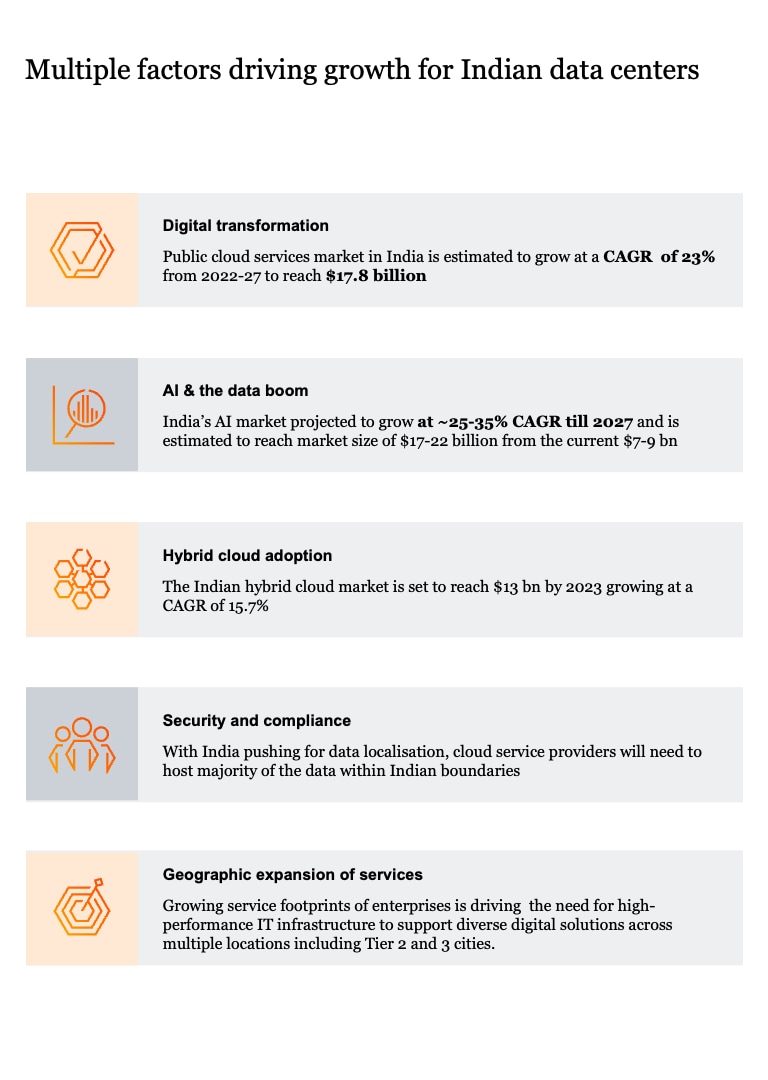
There are a multitude of growth indicators, latency and edge computing lead the
charts for edge deployments
End users driving data center demand
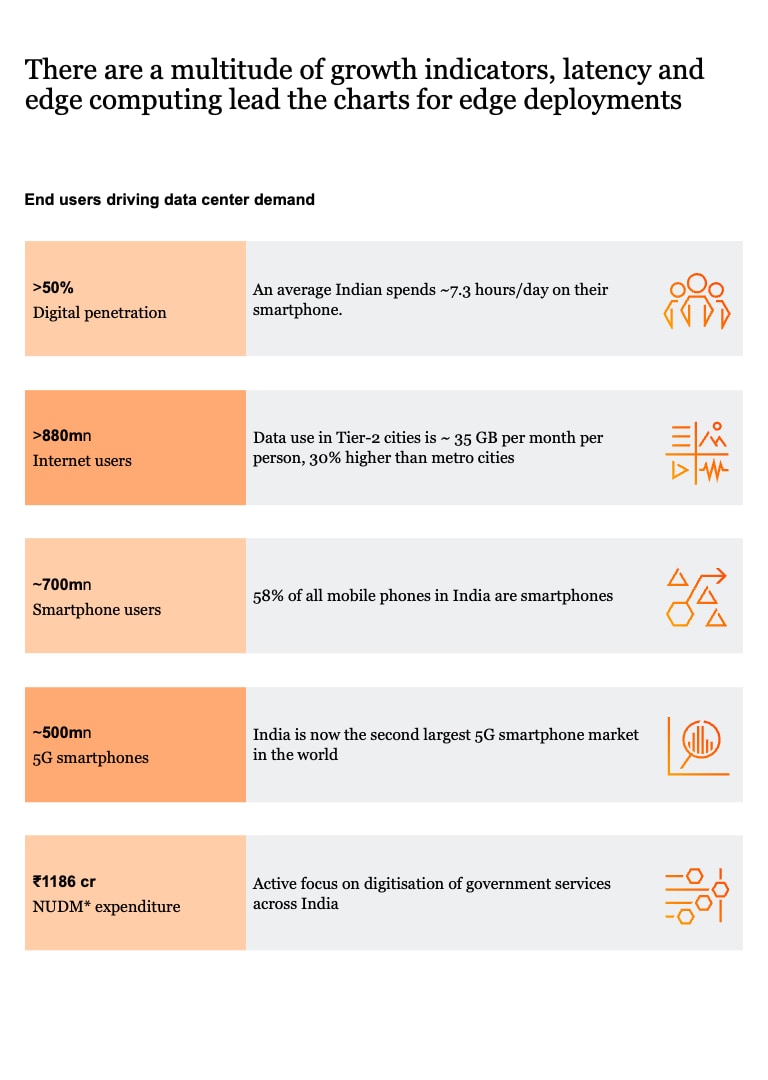
Low latency use-cases are driving the edge data center demand
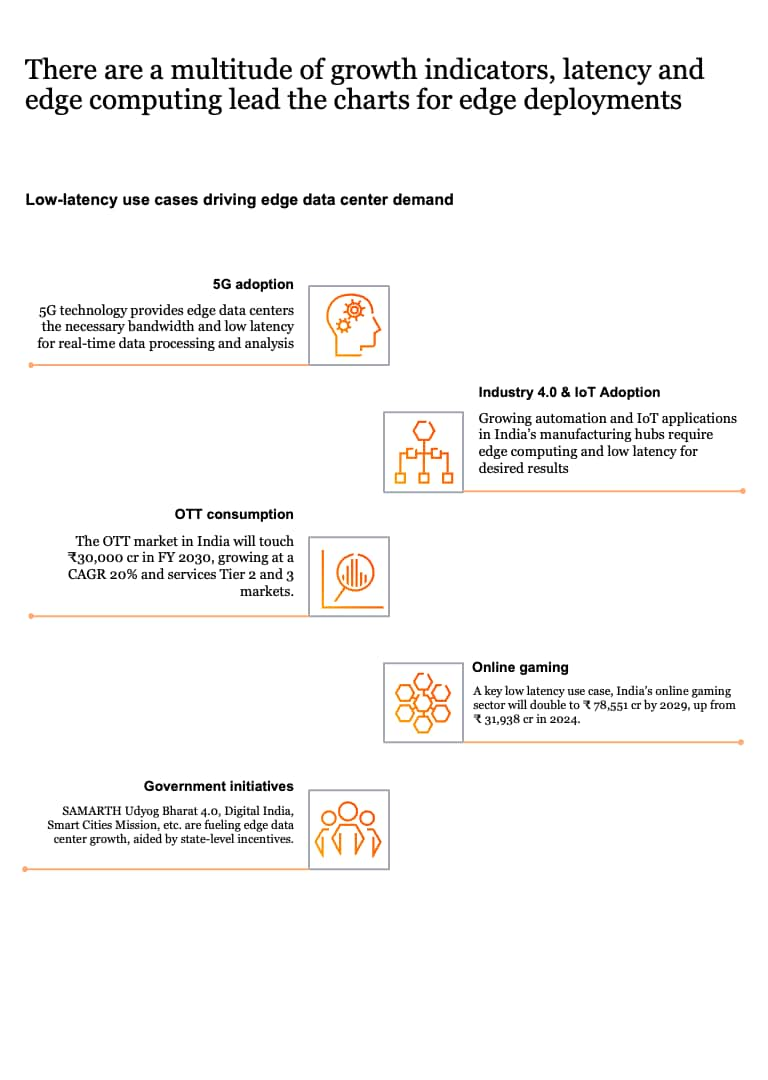
Tax Incentives & Benefits
Special Economic Zones: Establishing a data center in the SEZ provides innumerable tax benefits, including exemptions from customs duties on capital goods.
State-level incentives: Some Indian states offer additional tax benefits to attract data center investments.
Government Subsidies
Electricity Subsidy: Some states offer subsidies on electricity costs, further reducing operational expenses for data centers. (E.g. West Bengal)
Land Subsidy: Some states offer subsidized land to data center operators. (E.g. Utter Pradesh, Rajasthan, West Bengal)
Infrastructure Status
Indian Government is in the process of revamping the Data Center policy and giving data centers the benefits of having an infrastructure status
Renewable Energy Incentives
Electricity Subsidy: Some states offer subsidies on electricity costs, further reducing operational expenses for data centers. (E.g. West Bengal)
Streamlined Approvals
Single Window Clearances: Some states offer single-window systems for processing approvals and permits, expediting the establishment of data centers (E.g. Karnataka, Tamil Nadu & Haryana)
Easing RoW Permissions: The DoT is streamlining the process of obtaining RoW permissions for fiber networks, reducing bureaucratic hurdles.
Relaxed Building Regulations
Many states in India offer relaxed building regulations, including stamp duty exemptions, modified development control regulations, and potentially increased FSI and FAR limits, enabling streamlined construction and development processes.
Governments offer regulatory perks to boost digital infrastructure, improve public services, and promote innovation
